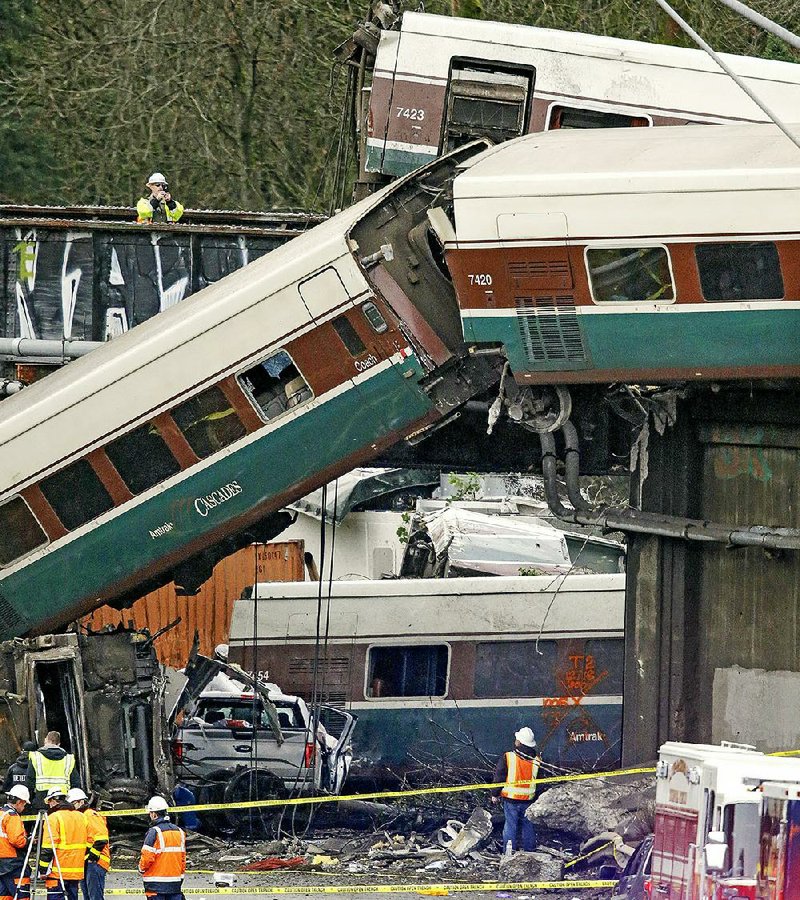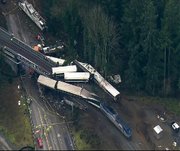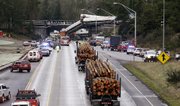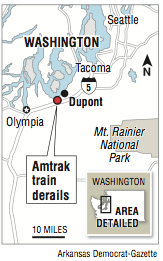DUPONT, Wash. -- A passenger train on a newly opened high-speed Amtrak route jumped the tracks on an overpass south of Tacoma on Monday, slamming rail cars into a busy highway, killing at least three people and injuring more than 100, authorities said.
The derailment of Amtrak Train No. 501, making the inaugural run of a new service from Seattle to Portland, Ore., dropped a 132-ton locomotive into the southbound lanes of the Northwest's busiest travel corridor. Two passenger coaches also fell partly into the traffic lanes, and two other coaches were left dangling off the bridge, one of them wedged against a tractor-trailer. On the highway below lay seven crumpled cars and trucks, as well as chunks of concrete that were ripped away from the overpass.
All 12 of the train's coaches and one of its two engines derailed. Federal investigators were at the scene trying to determine a cause.
"It felt like the end of the world, and I was standing amid the wreckage," said Emma Schafer, 20, a modern-dance student who was napping aboard the train with her shoes off when it derailed. She found herself in a coach dangling at a steep angle toward the highway -- with the man behind her yelling, his legs pinned, while a parent trapped with a baby in a restroom banged on the door for help getting out.
Click here for larger versions
Photos by The Associated Press
Photos by The Associated Press
"It felt oddly silent after the actual crashing," Schafer said. "There was a lot of metal, a lot of screeching, a lot of being thrown around. It was very quiet. Then there was people screaming."
The crash, which happened at 7:33 a.m. about midway between Tacoma and Olympia, killed at least three passengers, according to authorities.
About two hours after the accident, a U.S. official who was briefed on the investigation said he had been told that at least six people were killed. No additional briefings were provided by late afternoon, and the official said he had no new information to explain the discrepancy in the numbers. The official was not authorized to discuss the investigation publicly and spoke on condition of anonymity.
Investigators were still going through the wreckage and could not say for certain how many people had died. "It appears that all of the fatalities are contained in the rail cars that went into the woods," said detective Ed Troyer, a spokesman for the Pierce County sheriff's office, adding that rescue workers were using chain saws to try to reach victims in those cars.
CHI Franciscan Health, a regional hospital network, said more than 75 people were transported to nearby hospitals, including four who were classified "level red," reflecting the most severe injuries. Some of those injured were in vehicles on the highway and not on the train.
The train carried 77 passengers and seven crew members, said Gay Banks Olson, assistant superintendent of Northwest operations for Amtrak.
Paul Woodbury, 29, who was in the sixth car of the train when it derailed, described a chaotic scene, with severely injured people on the ground and screams piercing the air as he climbed out of the wreckage. Once outside, in the cool morning mist, "people stood around, shellshocked," he said, until emergency workers arrived to get them.
Other survivors told area media about picking through broken glass and twisted metal, struggling to pry out windows to escape, and using the flashlight function on their cellphones to see in the ruined, darkened coaches. Witnesses told of motorists leaving their vehicles on the highway to help pull people from the wreckage.
Some of the rail cars were too precarious for rescuers to enter in search of victims, so they didn't know whether anyone was left on board, said Brooke Bova, a spokesman for the Washington State Patrol.
"There are a lot of working parts here," Bova said during a media briefing Monday. She did not confirm the number of fatalities but said authorities were not doing rescue operations. "It is still evolving right now.
"We are waiting for [the National Transportation Safety Board] and Amtrak to come here so they can finish their investigation. It is safe to say this is going well into the night."
President Donald Trump wrote on Twitter that the crash on Amtrak's Cascades service showed the need for increased infrastructure spending.
"The train accident that just occurred in DuPont, WA shows more than ever why our soon to be submitted infrastructure plan must be approved quickly," Trump wrote. "Seven trillion dollars spent in the Middle East while our roads, bridges, tunnels, railways (and more) crumble! Not for long!"
The train and the line it traveled on were the products of just such investment.
Backed by Washington state, the regional Sound Transit agency used $180 million from the 2009 federal stimulus package to buy an old, 14.5-mile stretch of track and upgrade it for high-speed passenger service. The project, known as the Point Defiance Bypass, was devised to allow Cascades trains to stop using a more roundabout route that they shared with freight trains, making for faster, more reliable travel.
Washington and Oregon jointly own the Cascades service, and Amtrak operates it.
"There have been a lot of trial runs" on the line, Amtrak's Olson said. She said it was far too soon to discuss a cause of the disaster.
A website that maps location and speed using data from Amtrak's train tracker app shows the train was going 81.1 mph about a quarter-mile from the point where it derailed, where the speed limit is significantly lower.
A track chart prepared by the Washington Department of Transportation shows the maximum speed drops from 79 mph to 30 mph for passenger trains just before the tracks curve to cross Interstate 5.
The chart, dated Feb. 7, was submitted to the Federal Railroad Administration in anticipation of the start of passenger service along the new bypass route.
It wasn't clear how fast the train was moving when it derailed.
Kimberly Reason with Sound Transit confirmed that the speed limit at the point where the train derailed is 30 mph. Speed signs are posted 2 miles before the speed zone and just before the speed zone approaching the curve, she said.
Shortly before the accident, a passenger, Chris Karnes, chairman of the advisory board to Pierce County's transit agency, took to Twitter to marvel at how fast the train was, noting, "We are passing up traffic on I-5."
RADIO TRANSMISSION
In a radio transmission immediately after the accident, the conductor can be heard saying the train was moving around a corner and was crossing a bridge that passed over I-5 when it derailed. Dispatch audio indicated that the engineer survived with bleeding from the head and both eyes swollen shut.
"I'm still figuring that out. We've got cars everywhere and down onto the highway," he tells the dispatcher, who asked whether everyone is OK.
Aleksander Kristiansen, a 24-year-old from Copenhagen, Denmark, who's an exchange student at the University of Washington, was going to Portland to visit the city for the day.
"I was just coming out of the bathroom when the accident happened. My car just started shaking really, really badly. Things were falling off the shelf. Right away, you knew that this was not something minor," he said.
The back of his train car was wide open because it had separated from the rest of the train, so he and others were able to jump out to safety. He was at about the middle of the train, either the sixth or seventh car, he said, and was "one of the lucky ones."
Dr. Nathan Selden, a neurosurgeon at the Oregon Health and Science University in Portland, said he and his son drove through the accident scene while traveling north to visit Seattle. The doctor asked whether he could help and was ushered to a medical triage tent in the highway median.
The most seriously injured had already been whisked away, but the patients he helped appeared to have open head wounds or skull, pelvic or leg fractures, as well as small cuts and neck sprains, he said.
He called it a miracle that an infant at the scene appeared completely unharmed.
TRAIN-CONTROL TECH
Federal law requires railroads, by the end of 2018, to have technology known as positive train control, which automatically slows trains if they are exceeding speed limits or approaching dangerous conditions.
The state Department of Transportation has said that the entire Cascades route will have the system by mid-2018.
The technology wasn't in use on the stretch of track where the accident occurred, according to Amtrak President Richard Anderson.
On a conference call with reporters, Anderson said he was "deeply saddened by all that has happened today."
Gov. Jay Inslee of Washington, who declared a state of emergency, cautioned against jumping to the conclusion that excessive speed or shoddy work in upgrading the line were to blame for Monday's crash.
"Suspend judgment about what happened in this incident," he said, after visiting victims who were taken to the nearby DuPont City Hall. "No one knows what happened in this incident."
At a news conference at the safety board's headquarters in Washington, D.C., board member Bella Dinh-Zarr had few details about the crash or potential causes but said agency officials would know more once their team of 20 investigators arrived at the scene late Monday night.
Those investigators were to include at least a dozen specialists in train operations, mechanics, tracks, signal systems, human performance, and survival factors. The lead investigator is Ted Turpin, who also worked on the 2015 Amtrak derailment in Philadelphia and was the lead investigator for the Long Island Rail Road train crash at New York's Atlantic Terminal early this year.
"We'll have more information after we arrive on-scene and start the investigation," Dinh-Zarr said.
Information for this article was contributed by Kirk Johnson, Richard Perez-Pena and Niraj Chokshi of The New York Times; by Rachel La Corte, Gillian Flaccus, Michael Sisak, Manuel Valdes, Sally Ho, Phuong Le and Michael Balsamo of The Associated Press; and by Rodika Tollefson, Luz Lazo, Ashley Halsey III, Martine Powers and Faiz Siddiqui of The Washington Post.
A Section on 12/19/2017



